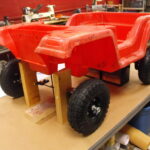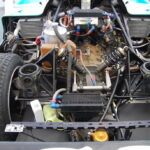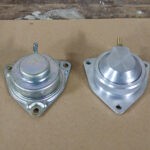Hole in Transmission: Can You Drive & How to Fix it?
A transmission system of a car is a complex system that is responsible for transmitting power from the engine to the four wheels. Gear shifting, and accelerating at higher speeds, all is possible due to the transmission. When any transmission component malfunctions, the whole car suffers.
You find out a hole in the transmission. What do you think, can you still drive the car with that hole?
Yes, if you have a tiny hole, then the car may be driven for a few miles, but it is not recommended. A hole in your transmission leaks out the transmission fluid causing a lot of damage to the transmission components. When sufficient fluid gets leaked, the transmission parts wear out rapidly and will eventually lead to complete failure.
In the remaining post, I will discuss some causes of a hole in your transmission, ways to fix it, and in the end, share some tips on improving transmission health.
What Causes a Hole in Transmission?
A hole in the transmission can be caused by multiple things. It may be a result of any physical damage, inappropriate repairs, heat, or overloading.
- Physical Damage
Physical damage can create a hole in the transmission. This can be from an accident or something hitting your car. For instance, if the car hits any bump from underneath.
Also read: The Cost of Replacing a Transmission (Ford, Honda, etc)
- Past repair/fixes on the transmission
If you had an accident in the past and a mechanic repaired one of the transmission components. Then, that inappropriate fixation might have malfunctioned and created a hole in the transmission.
- Heat/Changing Conditions
Sometimes severe heat and changing conditions also cause the fluid pipes in the transmission to crack. This usually happens over the years in old cars that remain parked outside and withstand severe weather conditions.
- Overloading
Overloading the vehicle, such as towing it, also puts strain on the transmission system and heats it causing cracks or holes in the transmission.
How Do You Know if You Have a Hole in Your Transmission?
The presence of the hole in the transmission can be diagnosed by a few symptoms.
- Leaking Fluid
The most common is leaking transmission fluid. The holes create a passage for the transmission fluid to flow outside the vehicle. So, if you see red or brown fluid under your car, it is likely due to an opening in the transmission.
- Difficulty Shifting Gears
If your car is having trouble going in gear, it is also a sign that there could be a problem with your transmission, likely a hole in the transmission.
When the fluid leaks out, eventually the level gets low enough that lubrication of the transmission becomes difficult. This makes it hard for you to change gears.
- Grinding Noises
Another sign you notice is grinding noises when shifting gears. Due to the lack of transmission fluid, the parts rub against each other creating grinding noises.
Also read: Bilstein vs. Koni Shocks: Which is a Better Choice?
Can You Patch a Hole in Your Transmission?
Yes, you can patch a hole in your transmission, but it is not recommended. A patch is only a temporary fix and will eventually need to be replaced. It is important to note that a patched transmission may not work well like the one that hasn’t been damaged.
If you do decide to patch your transmission, make sure you take it to a professional to have it done.
Holes in the transmission may be in the form of cracks in the fluid lines, crack/holes in the oil pan, or simply an opening anywhere in the transmission line.
Most of the time, people use JB weld theses to fill these cracks since it’s inexpensive and easier compared to other methods. Patching and Aluminum welding can also be done to fill up the holes.
Also read: 5 Reasons Why Europeans Hate Automatic Transmission
JB Weld
JB Weld is a type of epoxy that can be used to fix holes in metal. It is considered one of the strongest epoxies and can last for a long time. It may be an alternative to welding but it is not as strong as welding. JB Weld has a tensile strength of 5020 PSI and it can withstand a temperature up to 550 F, which is much lower than the average weld.
In case, you have small cracks in the fluid lines, or tiny holes anywhere, this may be an easy and inexpensive fix. If you have a hole in the oil pan, maybe JB Weld doesn’t work.
Other techniques (Patching, Aluminum Welding)
Another way is patching a metal sheet with the JB weld or any other epoxy such as RTV silicone. But is only a temporary fix and will eventually need to be replaced.
Patching may be done in case the hole is large enough. However, it is also important to note that a patched transmission may not work for a long time. And if you do decide to patch your transmission, make sure you take it to a professional to have it done.
Aluminum welding is a more permanent fix for a hole in your transmission. You can patch up the hole with an aluminum sheet and weld it. But remember that not all welders can weld aluminum, so you will need to find a welder that specializes in this type of welding.
Which Fix is Best for You?
JB Weld is suited normally for tiny holes or cracks in the transmission. And most users have complained about its inefficiency if the hole is in the oil pan. Similarly, patching is again a temporary fix and doesn’t have much tensile strength. So, in my opinion, the best option you can use is Aluminum welding due to its high tensile strength. It would last very long compared to the other two techniques.
How to Prevent Holes in Transmission?
It is a known fact that prevention is the best cure to any problem. So, let’s talk about some preventive measures you can adapt to avoid getting a hole in the transmission or at least fix it before it causes any damage to the car.
#1 Regularly Check your Transmission Fluid Level
One preventive measure you can take is to regularly check your transmission fluid levels. If you notice that your transmission fluid is low, be sure to top it off. You should also have your transmission flushed and replaced according to the manufacturer’s recommendations.
#2 Avoid Hard Shifting
Another way to prevent holes in your transmission is to avoid hard shifting. Hard shifting can cause wear and tear on your transmission, which can lead to holes and other damage.
#3 Avoid driving on Difficult Terrain
Avoid off-roading with a vehicle that isn’t built for it. When you drive over difficult terrain, it is possible that some rocks or stones may strike the transmission and damage it.
Tips to Improve Transmission Health
If your car has an automatic or manual transmission, here are a few things you can do to prolong its life and keep it running smoothly.
#1 Drive at Moderate Speeds
Avoid putting too much strain on the transmission by driving at moderate speeds and avoiding sudden starts and stops.
#2 Regularly get your car inspected
Regularly schedule maintenance for your car. Inspection and Maintenance are vital to the long-term performance of your vehicle. Change your transmission fluid every 15000 miles or once a year.
#3 Maintain the levels of Transmission Fluid
Transmission fluid may be checked regularly in the same way that oil is. Review your vehicle’s owner handbook for instructions. You can ensure that the fluid is at the right level. Having too little or too much in the pan can also produce complications.
#4 Don’t ignore any leaks from the car
If you notice any slightest leaks from underneath the car, don’t ignore them. It may be warning you of any problem. So, before it gets bigger, get to the root cause of the problem.
# 5 Don’t Overload the Vehicle
Towing forces the gearbox to work too hard, causing it to overheat and sustain severe damage. If your vehicle regularly does tow work, then consider installing an auxiliary cooler, it might help to reduce the temperature of the transmission.
Final Words
If you do find yourself with a hole in your transmission, it is important to act quickly. The longer you wait, the more damage would be done to the car. You may drive it slightly for a few miles, depending on the severity of the hole. However, it is important to take the vehicle to a mechanic and get the hole patched or welded.
Sources:






